Photons & Fusion
April 2011
Photons & Fusion is a monthly review of science and technology at the National Ignition Facility & Photon Science Directorate. For more information , submit a question.
Gearing Up for Experiments on NIF
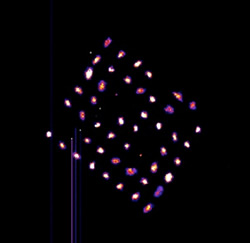 Image from the Static X-ray Imager of 46 beams hitting the bottom of an aluminum-coated disk target during the April 28 pointing validation shot. The image shows a precise pattern of x-ray spots where the laser beams hit a gold foil. This pattern is used to validate beam alignment.
Image from the Static X-ray Imager of 46 beams hitting the bottom of an aluminum-coated disk target during the April 28 pointing validation shot. The image shows a precise pattern of x-ray spots where the laser beams hit a gold foil. This pattern is used to validate beam alignment.
With the completion of the NIF Facility Maintenance and Reconfiguration period (see April 2011 Project Status), the NIF team moved quickly to return the facility to experiments. On April 28, a pointing validation shot was fired to a disk target at Target Chamber Center (TCC). This shot completed the operational qualification of the new Target Alignment Sensor.
On April 30, the team performed the first diagnostic re-commissioning and timing shot using a gold sphere at TCC to time the diagnostics in all three NIF diagnostic instrument manipulators (DIMs) in a single shot. The diagnostics involved were the DISC (DIM Insertable Streak Camera), the GXD (Time-Gated X-ray Detector), and the VISAR (Velocity Interferometer for Any Reflector). The shots used a variety of beam shapes and delays on the surface of the spheres to accurately cross-time the x-ray and VISAR shock diagnostics to the laser pulse. In addition, several beam-conditioning shots were fired over the April 30–May 1 weekend to laser condition the frequency conversion crystals with increasingly higher energy over the larger aperture. The larger aperture will enable NIF to operate at about 6% higher energy.
 Technicians ready a diagnostic instrument manipulator for testing.
Technicians ready a diagnostic instrument manipulator for testing.
 FM-to-AM compensator being tested.
FM-to-AM compensator being tested.
NIF Upgrade Will Result in Higher Peak Power
A new capability has been added to NIF with the commissioning of equipment designed to minimize the amplitude of high-frequency fluctuations in NIF's laser power. Called FM-to-AM compensators, the 48 new modules in the NIF Master Oscillator Room (MOR)—one for each quad of four beamlines—will increase the reliability of the NIF laser system and allow for higher peak operating power.
In the initial round of tuning at the end of April, the compensators reduced the average AM (amplitude modulation) level in the laser system to just 2 percent—a significant accomplishment by MOR team members Gaylen Erbert, Don Browning, Ernesto Padilla, Alex Deland, Angie Solis, and Gina Abercrombie.
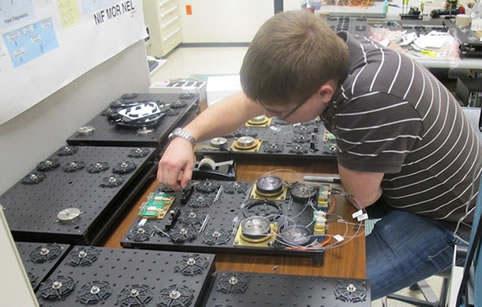 Alex Deland of the Master Oscillator Room team is shown preassembling some of the FM-to-AM compensators. These sophisticated devices significantly enhance the performance of the NIF lasers.
Alex Deland of the Master Oscillator Room team is shown preassembling some of the FM-to-AM compensators. These sophisticated devices significantly enhance the performance of the NIF lasers.
An Improved Model for Simulating Ignition Targets
After analyzing a series of 40 experiments that studied the performance of NIF hohlraums, LLNL researchers have developed an improved model for simulating hohlraums. This model will be used to design new targets for ignition experiments on NIF.
In the "hohlraum energetics" experiments conducted in the fall of 2009, hohlraums that varied slightly in size were shot at energies ranging up to 1.3 megajoules (see October 2009 Project Status). The primary goal of the experiments was to demonstrate that sufficient laser energy could be absorbed by the hohlraum, a hollow gold cylinder about five millimeters in diameter and ten mm long that surrounds a roughly two-mm-diameter fuel capsule. Laser light impinging on the inner walls of the hohlraum generates the x-ray "bath" needed to heat and ablate the fuel capsule, causing it to implode symmetrically and with enough velocity to achieve fusion ignition. An important secondary goal, the researchers said, was "to refine our radiation–hydrodynamic and laser–plasma interaction design tools based on the results of these experiments."
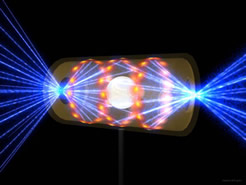 Artist's rendering shows a NIF target pellet inside a hohlraum capsule with laser beams entering through openings on either end. The beams compress and heat the target to the necessary conditions for nuclear fusion to occur.
Artist's rendering shows a NIF target pellet inside a hohlraum capsule with laser beams entering through openings on either end. The beams compress and heat the target to the necessary conditions for nuclear fusion to occur.
A hohlraum simulation model called the "high flux" model was deployed in the spring of 2010 that has several improvements over the simpler average-atom model originally used to design NIF targets, including a more complete atomic physics description. The new model was developed using the enhanced capabilities of LLNL's high-performance computers. When compared to the standard model, the new model produces a higher flux of x-ray emission and a higher flux of electron heat from a given laser-heated, high-atomic-number (such as gold) plasma.
When the results of the hohlraum energetics were compared with both the standard model and the high flux model, they showed that the high flux model reproduced the experimental signatures better than the previous model. Based on these results, the researchers have updated the NIF point design model to the high flux model and will base future ignition hohlraum designs on the predictions of the new model. (The point design describes the laser energy, power, pulse shaping, and beam smoothing requirements for achieving ignition.)
Lead authors Richard Town and Mordy Rosen and their colleagues reported the results of their analysis and the details of the new model in papers published online on April 7 in Physics of Plasmas (Phys. Plasmas 18, 056302 (2011); doi:10.1063/1.3562552) and on April 19 in High Energy Density Physics (High Energy Density Physics 7 (2011) 180-190; doi:10.1016/j.hedp.2011.03.008).
Installation of MEGa-ray Test Stand Begins
Installation of a test stand to develop and optimize an x-band (11.424 GHz) photoinjector as the electron beam source for LLNL's Mono-Energetic Gamma Ray (MEGa-ray) technology began in April. MEGa-rays are a new class of light source that produce gamma rays (high-energy x-rays) by colliding, or scattering, photons from a short-pulse laser with electrons moving at near the speed of light—a technique known as inverse Compton scattering. The backscatter of gamma rays is a million times more powerful than the incoming photons, and the peak brightness of a MEGa-ray pulse can be 15 orders of magnitude higher than any other man-made light in the million-electron-volt (MeV) spectral range.
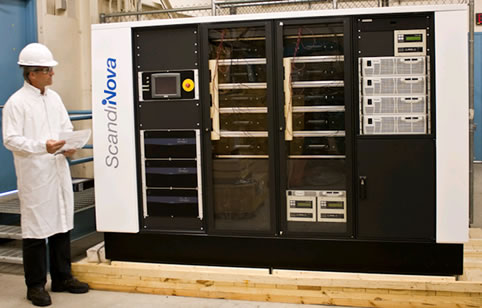 PS&A engineer Rick Cross inspects a 420-kilovolt modulator for the MEGa-ray photoinjector test stand being installed in Building 194.
PS&A engineer Rick Cross inspects a 420-kilovolt modulator for the MEGa-ray photoinjector test stand being installed in Building 194.
Researchers believe that optimizing the electron source has the potential to increase MEGa-ray's average gamma-ray brightness by as much as two orders of magnitude. The test stand project is a partnership between the Photon Science and Applications (PS&A) Division and LLNL's Physics and Life Sciences Directorate and is sponsored by the Department of Homeland Security's Domestic Nuclear Detection Office to explore the potential applications of MEGa-ray technology to identify and characterize special nuclear materials in cargo containers.
Fusion Target Physics Panel Briefed on LIFE and NIF
The National Academies' Panel on Fusion Target Physics met in Pleasanton, CA, and at LLNL on April 6 and 7 for briefings on LLNL's Laser Inertial Fusion Energy (LIFE) concept and on NIF's contributions to inertial fusion energy. The panel, which is charged with assessing the current performance of fusion targets associated with various inertial confinement fusion (ICF) concepts, serves as a technical resource to the National Academies' Committee on Inertial Confinement Fusion Energy Systems. The panel will prepare a report that describes the R&D challenges to providing suitable targets for ICF energy concepts.
NIF&PS Papers Win Recognition
An article by NIF&PS researchers titled "Sub-surface mechanical damage distributions during grinding of fused silica surfaces," which was published in the Journal of Non-Crystalline Solids in December 2006 (Journal of Non-Crystalline Solids 352, 5601-5617; doi:10.1016/ j.jnoncrysol.2006.09.012), has been recognized  as one of the journal's most cited articles between 2006 and 2010. "It's nice to know our work is getting recognized and is of strong interest to the community," said optics program manager Tayyab Suratwala. The paper was co-authored by Suratwala, Lana Wong, Phil Miller, Michael Feit, Joseph Menapace, Rusty Steele, Pete Davis and Dan Walmer.
as one of the journal's most cited articles between 2006 and 2010. "It's nice to know our work is getting recognized and is of strong interest to the community," said optics program manager Tayyab Suratwala. The paper was co-authored by Suratwala, Lana Wong, Phil Miller, Michael Feit, Joseph Menapace, Rusty Steele, Pete Davis and Dan Walmer.
In addition, a detailed description of the installation and precision alignment of NIF's optical systems, titled "National Ignition Facility System Alignment" and published in the March 10 issue of Applied Optics (Appl. Opt. 50, 1136-1157 (2011); doi:10.1364/AO.50.001136), was one of the most-downloaded Applied Optics papers in March. The paper was coauthored by Scott Burkhart, Erlan Bliss, Pascale Di Nicola, Dan Kalantar, Roger Lowe-Webb, Tom McCarville, Dan Nelson, Thad Salmon, Tania Schindler, John Villanueva, and Karl Wilhelmsen.
MIT Plasma Science Lab Develops NIF Diagnostics
The MIT Plasma Science and Fusion Center has played a key role in developing, testing, and calibrating diagnostic equipment for NIF, using the accelerator shown in the photo below. Among the diagnostics tested and calibrated by the Center’s PhD students and staff members are the Particle-Time-of-Flight diagnostic; the Magnetic Recoil Spectrometer, developed by MIT and the University of Rochester’s Laboratory for Laser Energetics in collaboration with LLNL; and the Wedge Proton Spectrometers, which are precision machined out of aluminum and are now being calibrated for diagnosing NIF shots starting in May.
 NIF Director Ed Moses (second from right) holds a tray containing several precision compact proton spectrometers during his April 22 visit to the MIT Plasma Science and Fusion Center. The Center’s Director, Dr. Miklos Porkolab, is on Moses’ right, and Research Leader Richard Petrasso is on his left.
NIF Director Ed Moses (second from right) holds a tray containing several precision compact proton spectrometers during his April 22 visit to the MIT Plasma Science and Fusion Center. The Center’s Director, Dr. Miklos Porkolab, is on Moses’ right, and Research Leader Richard Petrasso is on his left.
Researchers Co-author Plasma Physics Text Update
Two NIF&PS researchers have co-authored the second edition of a textbook on plasma physics, Plasma Scattering of Electromagnetic Radiation, which was recently published by Academic Press. NIF&PS plasma physicist Siegfried Glenzer and former NIF&PS researcher Dustin Froula joined John Sheffield of the University of Tennessee and Neville Luhmann of the Department of Applied Science at UC Davis in updating the original 1975 monograph on the theory and measurement of light scattering in plasmas ("scattering" occurs when a beam of particles is dispersed by collisions or similar interactions).
which was recently published by Academic Press. NIF&PS plasma physicist Siegfried Glenzer and former NIF&PS researcher Dustin Froula joined John Sheffield of the University of Tennessee and Neville Luhmann of the Department of Applied Science at UC Davis in updating the original 1975 monograph on the theory and measurement of light scattering in plasmas ("scattering" occurs when a beam of particles is dispersed by collisions or similar interactions).
The new version discusses the applications of a diagnostic technique called Thomson scattering, which include the full range of plasmas used in research and industry. Light scattering in plasmas is essential in the research and development of fusion energy, environmental solutions, and electronics. This book is a comprehensive resource specific to this plasma scattering technique.
NIF Greeted More than 4,500 Visitors in 2010
A total of 4,588 visitors enjoyed NIF's hospitality last year as the facility hosted 687 tours—an average of nearly two tours a day—for visitors ranging from junior high and high school students to generals, admirals, CEOs, and heads of government agencies. More than 110 tours each were given to VIPs and representatives of private industry and universities, while 50 tours were held for visitors from other countries and 31 for members of the news media.
NIF Director Ed Moses credited the organizers and tour guides who were able to maintain an active tour program even as NIF was conducting almost daily laser shots and upgrading the facility for high-yield experiments beginning in May. "Many people teamed up to make it work," Moses said. "The number of people wanting to see NIF shows what a special place it is and why it's something to be proud of."
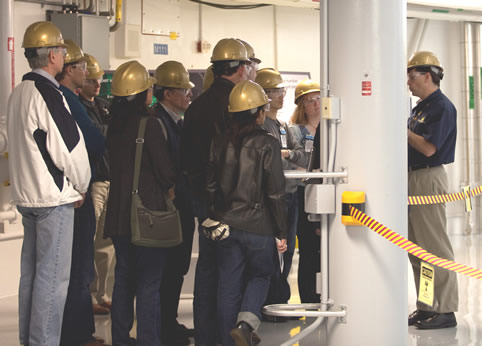 Members of the Caltech Alumni Association toured NIF on April 8.
Members of the Caltech Alumni Association toured NIF on April 8.




